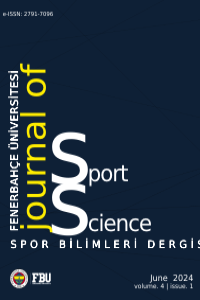Investigation of the Performance of Adolacence Male Swimmers According to Different Backstroke-to-Breaststroke Turn Techniques
Öz
The aim of the study was to investigate the performance of adolescent male swimmers according to different backstroke to breaststroke techniques (open, somersault, buckets, crossover). Ten male swimmers (𝑋̅age=14,27±1,27years) participated in the study voluntarily. After the body weight, height and arm length measurements of the swimmers were completed, the swimmers performed standard dry-land and water warm-ups. Then, the swimmers were asked to perform 50 meters (m) maximal performance. Swimmers were instructed to perform the four turning techniques once on four different days using a randomisation. The performances were recorded with SJCAM-4k camera and the images were analysed in Kinovea 0.9.5 software. Swimming (backstroke and breaststroke stroke count, rate, length, index, speed and finish times) and turning performance parameters (turning phases stroke count, rate, length, index, speed, turning time and turning distance) were calculated in this programme. The data were analysed with Wilcoxon test in IBM SPSS 24.0 programme. The difference between somersault and open turns in 25m breaststroke finish time, stroke index, speed and underwater distance was found in favour of open turn. The difference in the first 10m breaststroke time, stroke index and speed between crossover vs open and buckets turns was found in unfavour of crossover (p<0.05). As a result, it is suggested that the backstroke to breaststroke technique differs according to swimming and stroke performance parameters and therefore individual action should be taken in determining the best turn technique of swimmers.
Anahtar Kelimeler
Kaynakça
- Akın, G., Tekdemir, İ., Gültekin, T., Erol, E., & Bektaş, Y. (2020). Antropometri ve spor. Ankara, Alter Yayıncılık. Bay, S. (2021). How to find your best backstroke-to-breaststroke IM transition. U.S. Masters Swimming. usms.org.
Adölesan Erkek Yüzücülerin Sırtüstünden Kurbağalamaya Farklı Dönüş Tekniklerine Göre Performanslarının İncelenmesi
Öz
Araştırmanın amacı adölesan erkek yüzücülerin sırtüstünden kurbağalamaya farklı dönüş tekniklerine (açık, takla, naber, yuvarlanma) göre performanslarının incelenmesidir. Araştırmaya 10 erkek yüzücü (𝑋̅yaş=14,27±1,27yıl) gönüllü olarak katılmıştır. Yüzücülerin vücut ağırlığı, boy ve kulaç uzunluğu ölçümleri tamamlandıktan sonra yüzücüler standart kara ve su ısınmalarını uygulamıştır. Ardından yüzücüler 50m maksimal (25m sırtüstü 25m kurbağalama) yüzme performansını sergilemeleri istenmiştir. Yüzücülerin, dört dönüş tekniklerini dört farklı günde (gün aşırı) birer kez randomizasyon şeması kullanılarak uygulamaları sağlanmıştır. SJCAM-4k kamera ile performanslar kaydedilip görüntüler Kinovea 0.9.5 programında incelenmiştir. Bu programda yüzme performans parametreleri (sırtüstü ve kurbağalama kulaç sayısı, kulaç sıklığı, kulaç mesafesi, kulaç indeksi, hız ve bitiş süreleri) ile dönüş performans parametreleri (dönüş bölümü kulaç sayısı, kulaç sıklığı, kulaç mesafesi, kulaç indeksi, hız, dönüş süresi ve dönüş mesafesi) hesaplanmıştır. IBM SPSS 24.0 programında Wilcoxon testi ile veriler analiz edilmiştir. Takla ile açık dönüşleri arasında 25m kurbağalama bitiş süresi, kulaç indeksi, hız ve sualtı mesafesinde farklılık açık dönüş lehinde bulunmuştur. İlk 10m kurbağalama süresi, kulaç indeksi ve hızda yuvarlanma ile açık ve naber dönüşleri arasında farklılık yuvarlanma dönüş alehinde tespit edilmiştir (p<0,05). Sonuç olarak; sırtüstünden kurbağalamaya dönüş tekniklerinin yüzme ve dönüş performans parametrelerine göre farklılık gösterdiği bu nedenle yüzücülerin en iyi dönüş tekniğini belirlemede bireysel hareket edilmesi gerekliliği önerilmektedir.
Anahtar Kelimeler
Kaynakça
- Akın, G., Tekdemir, İ., Gültekin, T., Erol, E., & Bektaş, Y. (2020). Antropometri ve spor. Ankara, Alter Yayıncılık. Bay, S. (2021). How to find your best backstroke-to-breaststroke IM transition. U.S. Masters Swimming. usms.org.
Ayrıntılar
| Birincil Dil | Türkçe |
|---|---|
| Konular | Spor Biliminde Biyomekanik |
| Bölüm | Araştırma Makaleleri |
| Yazarlar | |
| Yayımlanma Tarihi | 30 Haziran 2024 |
| Gönderilme Tarihi | 7 Nisan 2024 |
| Kabul Tarihi | 21 Mayıs 2024 |
| Yayımlandığı Sayı | Yıl 2024 Cilt: 4 Sayı: 1 |


